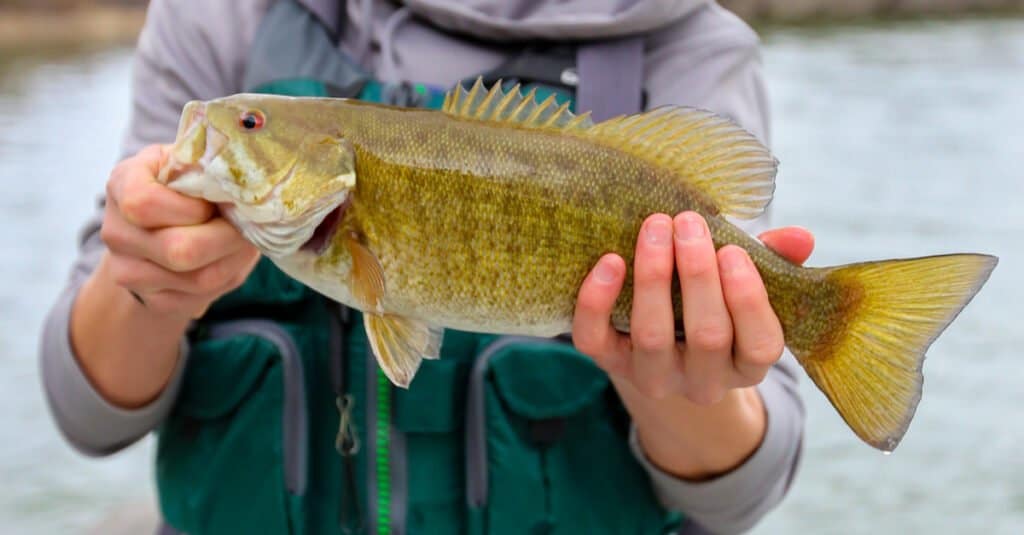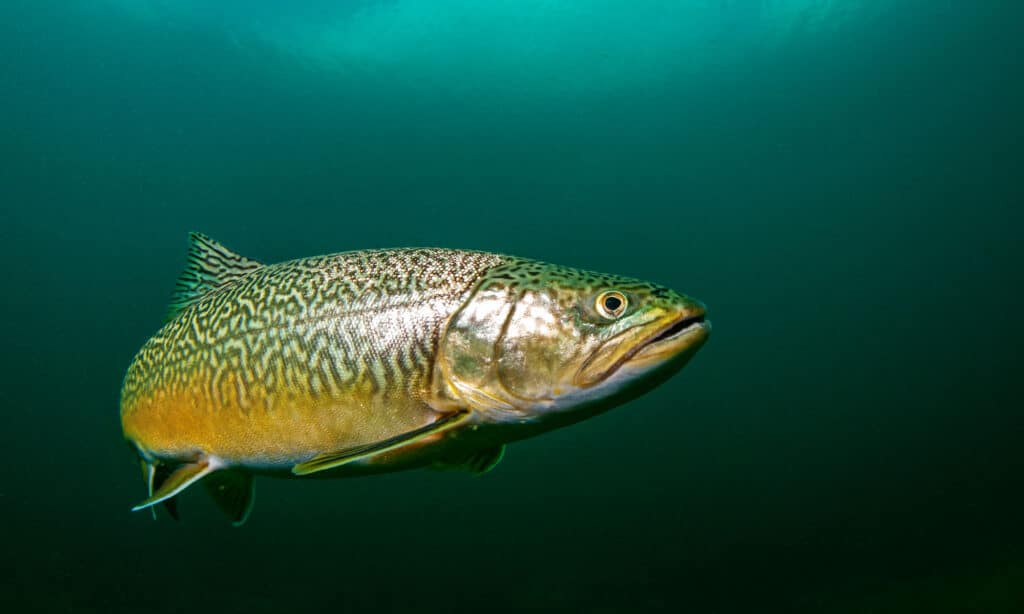The state of Nevada is full of popular sports fish and equally famous lakes and rivers to find them in. There are over 30 lakes in Nevada, and they all have different shapes, sizes, and depths. The unique environments are home to over 60 native species. However, only some fish species are good for targeting in the summer. To help you have the most success, we’ve put together this short fishing guide full of the best angling tips!
Read on to learn about the 5 best fish to catch in Nevada this summer.
1. Brown Trout

Brown trout prefer cold waters.
©iStock.com/KevinCass
One of the best fish to catch in Nevada this summer is the brown trout. Found in lakes, streams, and rivers, brown trout are abundant. As European species of salmon, these fish thrive in various habitats. However, they tend to prefer cold water. That’s why you’ll have to go deep when you’re trout fishing! As you go deeper into the water, the temperatures drop to trout-friendly numbers between 54-65 °F. If you find a slow-moving run or pool of water, it’ll likely have trout in it.
A couple of the challenges you’ll have to overcome include thick grass and excessive brush. You may need to use a kayak or canoe to get the best access to certain lakes. Make sure you have tempting bait, such as minnows or live nightcrawlers. Brown trout eat small clams, insects, snails, worms, and small fish. Any type of bait that can imitate their regular diet will help you entice them to bite. If you’re using artificial bait, use primary colors.
2. Wiper

Wipers enjoy swimming in large lakes and reservoirs.
A hybrid of striped bass and white bass, wipers are popular gamefish. They closely resemble stripers, but their mouths are much smaller. Wipers enjoy swimming in large lakes and reservoirs. They can grow to be 2 feet long and weigh around 12 pounds. However, you could catch a lunker weighing over 20 pounds!
You’ll get the most action in the early morning and late evening hours. Wipers are also good fish for a round of night fishing. Whenever there are low light conditions, you’ll have an advantage. The low light encourages them to feed, and it makes them more aggressive biters.
Try using spinnerbaits or drop shot rigs with plastic minnows. You can also use live baits such as minnows and nightcrawlers. Since they’re schooling fish that target large prey, a variety of baits will work. If minnows aren’t working, switch to crayfish, grasshoppers, or crickets. Once you set your hook, prepare for battle! Wipers are famous for being among the hardest fish to catch. They’re fast and strong-willed, so you’ll have to bring your A-game.
3. Smallmouth Bass

Smallmouth bass prefer rocky shorelines.
©CSNafzger/Shutterstock.com
Target a member of the sunfish family, the smallmouth bass. A popular gamefish, smallmouth bass live in swift-moving streams and currents. They prefer clear waters and love lakes with rocky or gravely bottoms and shorelines.
Lakes undergo geologic stages of development, and one of the earliest stages is called oligotrophic. The lakes have steep drop-offs, rock basins, and cold deep waters during this stage. Smallmouths prefer lakes in the oligotrophic stage, and Nevada’s full of them.
Congregating by shallow water structures, smallmouths also swim around the wide open areas. For the most action, you’ll want to fish when it’s the coolest outside. Try going out right before sunrise and in the late afternoon. You’ll also have luck just after sunset.
Some of the best baits to use include jigs, jerk baits, and blade baits. If you’re using jigs, work the deeper waters. If you’re casting a plastic lure, focus on the rocky shorelines.
4. Channel Catfish

Channel catfish are bottom-dwelling omnivores.
©Aleron Val/Shutterstock.com
One of the most popular catfish species to target in Nevada is the channel catfish. Channel catfish have blue-gray sides with a black back and a completely white belly. In rare cases, recessive alleles produce albino channel catfish with a peach coloration.
As bottom dwellers, channel catfish are omnivores. They eat a diet consisting of plants and small animals like fish. While they’re available year-round, summertime is the best time of year for catfishing. These fish enjoy shallow waters in the winter. As the warm season rolls around, they start seeking out cooler, deeper waters.
For the best results, you’ll want to use live bait. Some of the best live baits include shrimp, crawfish, gizzard shad, and brim. Seek out the deepest pools of rivers. To catch a lunker, use big bait and put it under a large float at mid-depth. Let the wind slowly troll the bait for you, and wait for a bite.
5. Tiger Trout

Tiger
trout are a hybrid mix between brook and brown trout.
©MartinRejzek/Shutterstock.com
Another one of the best fish to catch in Nevada this summer is the tiger trout. Tiger trout are a hybrid mix between brook and brown trout. Unlike their parental species, tiger trout are rare. You’ll have to know exactly when to look for them and bring the most tempting type of bait.
Famous for its tiger-like stripes, the tiger trout prefers cold water lakes. As long as the water has enough aquatic vegetation, like algae, the trout will feel at home. By the end of the summer, the warm waters will push the trout away from surface flats and shallow waters. You’ll have to use a boat and bring the right type of equipment for deep water fishing.
Typically, you’ll find tiger trout in-depths of 10-20 feet. However, they can go deeper. Don’t try fishing in the middle of the day. The waters will be too warm. Instead, early morning and late evening will be the best times to hit the water. You’ll also want to fish on days with the best low-light conditions. If it’s early morning on an overcast day, you’ll be tipping the odds in your favor.
Finally, don’t overthink your line choice. You won’t go wrong with a spinning setup that uses 6 pounds of fluorocarbon. You could also use a 10-pound braid with a 6-foot fluorocarbon leader. Now get out there and start reeling in your catches!
The photo featured at the top of this post is © Jennifer White Maxwell/Shutterstock.com
Thank you for reading! Have some feedback for us? Contact the AZ Animals editorial team.







